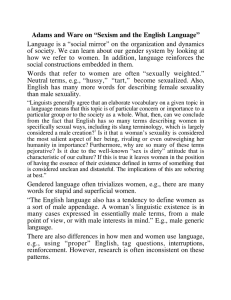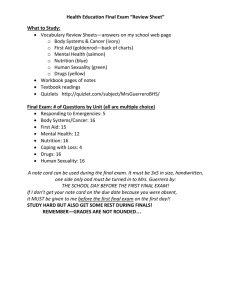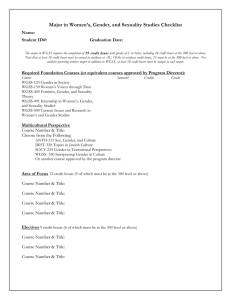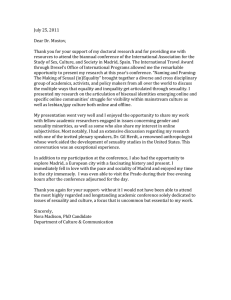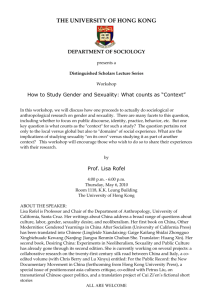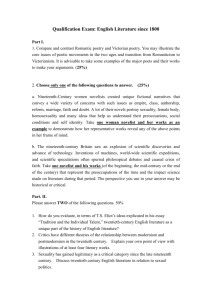T Beyond the Americas Are Gender and Sexuality Useful Categories of Historical Analysis?
advertisement
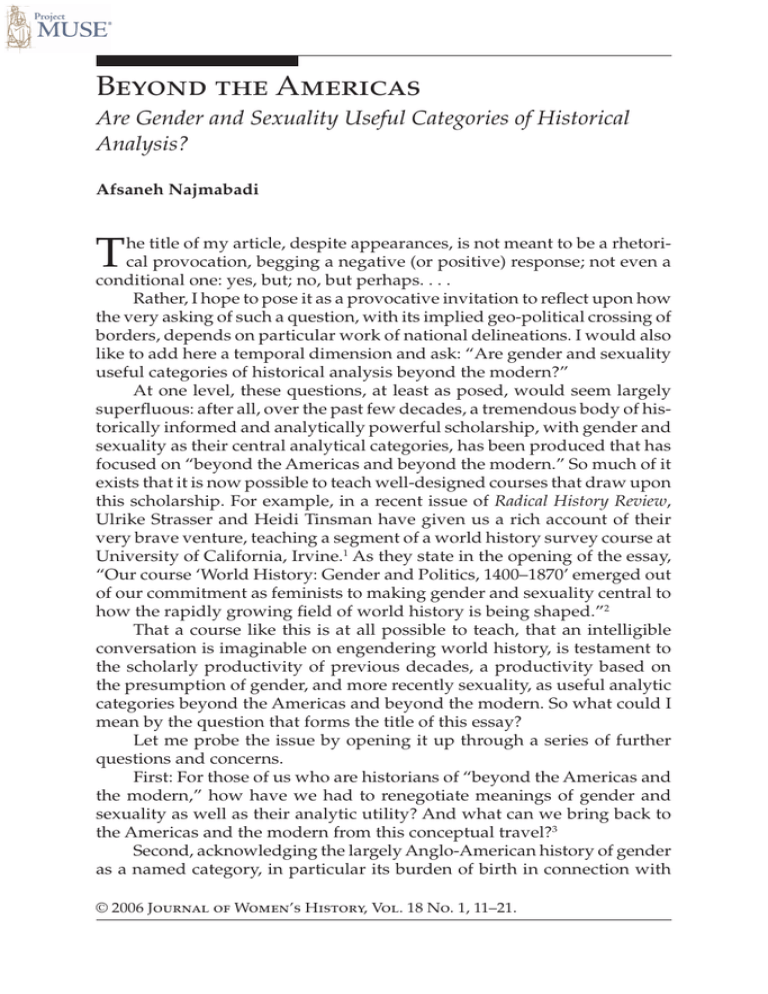
2006 Afsaneh Najmabadi Beyond the Americas 11 Are Gender and Sexuality Useful Categories of Historical Analysis? Afsaneh Najmabadi T he title of my article, despite appearances, is not meant to be a rhetorical provocation, begging a negative (or positive) response; not even a conditional one: yes, but; no, but perhaps. . . . Rather, I hope to pose it as a provocative invitation to reflect upon how the very asking of such a question, with its implied geo-political crossing of borders, depends on particular work of national delineations. I would also like to add here a temporal dimension and ask: “Are gender and sexuality useful categories of historical analysis beyond the modern?” At one level, these questions, at least as posed, would seem largely superfluous: after all, over the past few decades, a tremendous body of historically informed and analytically powerful scholarship, with gender and sexuality as their central analytical categories, has been produced that has focused on “beyond the Americas and beyond the modern.” So much of it exists that it is now possible to teach well-designed courses that draw upon this scholarship. For example, in a recent issue of Radical History Review, Ulrike Strasser and Heidi Tinsman have given us a rich account of their very brave venture, teaching a segment of a world history survey course at University of California, Irvine.1 As they state in the opening of the essay, “Our course ‘World History: Gender and Politics, 1400–1870’ emerged out of our commitment as feminists to making gender and sexuality central to how the rapidly growing field of world history is being shaped.”2 That a course like this is at all possible to teach, that an intelligible conversation is imaginable on engendering world history, is testament to the scholarly productivity of previous decades, a productivity based on the presumption of gender, and more recently sexuality, as useful analytic categories beyond the Americas and beyond the modern. So what could I mean by the question that forms the title of this essay? Let me probe the issue by opening it up through a series of further questions and concerns. First: For those of us who are historians of “beyond the Americas and the modern,” how have we had to renegotiate meanings of gender and sexuality as well as their analytic utility? And what can we bring back to the Americas and the modern from this conceptual travel?3 Second, acknowledging the largely Anglo-American history of gender as a named category, in particular its burden of birth in connection with © 2006 Journal of Women’s History, Vol. 18 No. 1, 11–21. 12 Journal of Women’s History Spring psycho-behavioral categories of gender-role determination, how have we reckoned with the many effects of that genealogy?4 Third, and related to the second, have we really finally done away with gender binaries in our historical and analytical work? What can we make of the fact that the only categories of gender that run through so much of our gender scholarship are women and men, masculinity and femininity? How do we approach the problem of gender’s historical and narrative effect for its own production as a binary? I do not here mean to revisit the old discussions on third and fourth, et cetera, genders and sexes. That is a rich discussion, and I do not think we have learned enough from it. In part that is perhaps a failure of disciplinarity. Much of that debate took shape in anthropology; not enough of it seeped through our departmental walls into history. But my point here is a different one: the presumption of the very definitional matrix of the two terms. What happens if masculinity is analyzed as an internally fractured concept, as it is done in some of the studies that bring race and ethnicity to bear on masculinity (that is, when the lines of differentiation become redrawn; in rather simplistic binary terms, when white and black, rather than male and female, delineate the parameters of masculinity); or where lines of womanliness are drawn through locations in and across religious or national communities rather than vis-à-vis males of the same community. And what about age fractures: what if the critical delineation for adult manhood is not with womanhood but with adolescent malehood? Though there is an increasing body of scholarship moving in these directions, we continue to populate our work primarily with men and women. Fourth, to the extent that we continue to narratively reproduce gender binaries, are we not naturalizing (and by implication atemporalizing) gender, despite our best intentions? “Gender and sexuality are arguably the two historical phenomena that appear most natural and unchanging to our students,” Strasser and Tinsman note.5 But the categories appear that way not only to students, or even to the larger culture—witness the reactions to the reactions to the comments made by Harvard’s president, Larry Summers. By focusing our gender analytics on men and women, do we, as historians, not continue to naturalize manhood and womanhood and thereby underwrite heteronormativity? This is, of course, the effect of our own initial intervention: namely, making a distinction between sex and gender, a point at the heart of Judith Butler’s Gender Trouble that I do not intend to belabor here. But let me use an example from Strasser and Tinsman’s essay to indicate how a particular clustering of our analytical categories produces a naturalization (and by implication atemporality) of these very categories: “Against this backdrop, we want to challenge our students’ understanding of the political by having them analyze why ruling 2006 Afsaneh Najmabadi 13 authorities try to regulate sexual behavior and impose norms of femininity and masculinity on the populace. We ask them to reflect on how gender and sexuality are used to establish structures of authority and to maintain religious, national, class, and racial boundaries.”6 Note the cluster around gender and sexuality, femininity and masculinity, which then becomes linked with another set of categories: religion, nation, class, and race. What do we lose by, and not only gain from, clustering gender with sexuality?7 What are the effects of making gender a category of analysis that has a privileged connection to sexuality? What are some possible occlusions and amnesia that this privileging may produce? Put somewhat differently, how has sex become sex? In Persian, for instance, the use of the word jins (meaning kind, species, as well as grammatical gender) for sex has a very recent origin. I have come across a couple of references in the 1920s, a few more in the 1930s, and a lot more in the 1940s. The usage really took off in the 1950s and by the 1960s it became used widely, except that in medical discourse (excluding psychology texts), it was still not the dominant word until a decade or so later. The usage of jins for sex seems to have come into Persian from translated books on “how to make your marriage happy” and child pop psychology, and then from the late 1950s with psychology and psychoanalysis becoming popular, this usage became common.8 If even the words we use have a multilayered genealogy of meaning, we can ill afford to lose sight of how our historical narratives have contributed to a re-naturalization of sex and binarization of gender. Let me expand a bit on these questions by telling a cautionary tale from my own research on nineteenth-century Iran.9 Years ago, probably in the late 1980s and most likely when I had just read Scott’s famous essay, in the heat of a polemical exchange with a historian of Qajar Iran (1785–1925), who expressed regret and dismay that doing Qajar women’s history was impossible because few historical sources and solid extant records about women of that period existed, I retorted, “But if we use gender analytically, sources about men are also sources about women.”10 From the moment of its utterance, the sentence began to haunt me: How do we employ gender analytically so as to write history from which women were not absent and gender was not a missing category; one in which women and gender were not afterthoughts and appendices? What work did gender do in the making of Iranian modernity and how did it perform this cultural labor? If central concepts of Iranian modernity were gendered, how were they gendered and what effects did their genderedness produce for constitution of Iranian men and women of modernity? My research thus began as a by-now familiar study of the constitutive work of gender on several distinct but interrelated levels: metaphoric, symbolic, 14 Journal of Women’s History Spring narrative, and rhetorical. But as I was finishing my manuscript some ten years later, I became uneasy, aware that something was amiss. I realized, for instance, that my association of beautiful faces with femininity and femaleness did not correspond to nineteenth-century Qajar sensibilities. In the Qajar period, a beautiful face could be either a young male or female with identical features. This recognition was not an incidental and localized trouble. Sexuality and masculinity crept in as haunting afterthoughts in several chapters of the book. As I had set about to read Iran’s “long nineteenth century” as a century centrally shaped by the transformation of gender, I had overlooked how this had depended on the transformation of sexuality. This conclusion turned out to be more radical for my manuscript than I had anticipated. My project of writing a history of Iranian modernity in which issues of gender and women would not be afterthoughts and appendices had produced its own afterthoughts and appendices. I ended up reconceptualizing and rewriting the entire manuscript. Indeed, I had to reread my sources. This was a humbling experience, not only because of the shock of realizing how I had set aside, literally marginalized, as irrelevant to my project, material related to sexuality, but more significantly, for realizing how that marginalization had damaged my project of writing a gendered narrative of Iranian modernity. The project had begun as a project on the work of gender for the formation of Iranian modernity on iconic, narrative, metaphoric, and social levels. But there was another labor of gender that I had overlooked: the production of gender itself as a binary, man/woman— itself an effect of a paradigmatic shift in categories themselves from a view in which all gender categories were defined in relation to adult manhood to a view in which woman and man became opposite and complimentary, to the exclusion of other categories that would not fit. Thinking of gender as man/woman turned out to be a very modern imperative. I had overlooked the erasures that made this binarity of gender possible in the first place. I had to confront the assumed normalcy of the man/woman binary by mapping modes of male-ness in nineteenth-century Iran that were distinct from manhood, but not in reference to womanhood. Moreover, gender as a binary has now become a template for categories of modern sexuality. Our contemporary binary of gender translates any fractures of masculinity into effeminization. Nineteenth-century Iranian culture, however, and perhaps before and beyond, had other ways of naming a young adolescent male and an adult man desiring to be objects of desire for adult men that were not equated with effeminacy. My cautionary tale begins to thicken at this point! A critical pre-publication review of my book brought to my attention that as concerned as my book had been with seeing the work of production of gender and sexual 2006 Afsaneh Najmabadi 15 exclusions and margins in the shaping of Iranian modernity, it had produced its own margins and exclusions. As the critic put it: “[The book] cannot but leave the reader pondering a question that haunts the text: Where is any account or analysis of women’s homoeroticism? This writing of history, which questions heteronormative narratives by centering men as those who desire and are the objects of desire, becomes complicit with discourses that see sexuality and eroticism as the exclusive domains of men when it ignores traces of women’s desire (same-sex or otherwise). . . . [It] repeats the amnesia that erases same-sex practices and desires of women.”11 To summarize a sharp critique into one line: The overall narrative effect of my book had put woman in a position to carry the burden of gender and man that of sexuality. While my book had challenged the modern binarization of gender by mapping out other male subjectivities than adult male masculinity, it retained a single sign for female: Woman. “What if the female-male binary that we take for granted (as the book argues),” asked Shakhsari, “is further complicated not just by manhood’s demarcation in relation to amrad [male adolescence], but also by an abject figure whose menace has completely erased the memory of her existence?” How does one explain that while alternative masculinities can be retrieved from historical memory (though with much embarrassment and pain), alternative femininities have remained seemingly nameless? This was not a criticism I could deflect! It immediately became the focus of my new intellectual obsession. How does one read the texts and see the visual culture of nineteenth-century Qajar Iran for traces of female eroticism? This question cannot simply retrace the same methodological routes as the previous book. From some preliminary readings and my knowledge of Qajar society as a homosocially structured culture, it would seem likely that female–female relations would have a different social context compared to those among men. The latter took shape at the junction of several distinct webs of meaning: the transition of young adolescents from the world of mother to the world of father; religio-cultural-political-artisanal male fraternities; Sufi brotherhoods; concepts of love and beauty and the literary cultural imagination shaped by them—all of these were carried in complex ways into the pattern of male–male relations, giving it dominantly, though by no means exclusively, a character of intergenerational, leader/follower, master/pupil type of relation, with the implication that, past a certain age, it would be shameful for a male to be the object of love of another male. This admittedly simplified sketch did not seem to pertain to “the world of women.” Kathryn Babayan’s work, for instance, on women’s relationships in Safavid Iran (sixteenth through early eighteenth centuries) has mapped out how the discourse of love, separation, and sorrow from Sufi devotional literature was rearticulated by an adult woman to narrate her 16 Journal of Women’s History Spring love for another adult woman.12 Some of these analytical and methodological issues have been raised over the past decades in the work of such scholars as Lillian Faderman, Martha Vicinus, Valerie Traub, Carolyn Dinshaw, Judith Bennett, Jody Green, Bernadette Brooten, and Alan Bray. These debates were in part opened up and informed by Foucault’s The History of Sexuality. In particular, as far as the elsewhere and else-time of modern EuroAmerican landscape is concerned, the scholarship on the “history of sexuality” has taken two major directions. One direction, informed by anthropological studies of largely contemporaneous societies, has sought to open up the possibilities of genders and sexualities beyond the two.13 Anthroplogist Kath Weston has called this trend the “ethnocartography of homosexuality,” and has criticized its counting impulse.14 The taxanomical drive is enacted not only on other places but also on other times. Here the impulse to categorize identifications and desires intersects with the other direction that many of the studies of sexuality concerned with the elsewhere and else-time of modern Euro-American landscape have taken; namely, studies that are based on dividing cultures into those that prohibitively regulate(d) same-sex desire through typologizing human beings into homosexuals and heterosexuals (modern Euro-America), and those in which prohibitions and punishments were centered around particular same-sex acts, while other same-sex practices may have been accepted and homoeroticism celebrated. Greek and Roman antiquity became the paramount examples of the latter.15 These works have been criticized by writers who, to varying degrees and in different forms, believed that notions of the homosexual and homosexuality were fruitfully applicable for writing histories of sexualities in these other places and times.16 This debate took an important step out of its methodological deadlock with David Halperin’s 1998 essay, in which he emphasized that the projects of writing histories of sexuality (or critique of Foucault’s and Foucauldians’ histories of sexuality) had read Foucault’s The History of Sexuality as a history of sexuality, rather than as theoretical propositions about different regulatory modes of generating sexuality.17 That The History of Sexuality has been read as a history of sexuality may have resulted in part from a shift in the direction of Foucault’s work from the projected volumes that were to follow volume one to the actual volumes that appeared subsequently.18 In a sense, volume one, along with a number of previous works of Foucault, had stood in connection with and on the ground of much of the previous social history of France. It projected a different notion of modern power that is by now well-known, that of a disciplinary society and culture, centered on the concept of bio-power, a power concerned with life rather than with death, with production of 2006 Afsaneh Najmabadi 17 governmentable citizens. As scholars Daniel Boyarin and Elizabeth Castelli have noted, it is indeed productive to identify “a doubled scheme” in The History of Sexuality and to read it as an ambiguous project, “between the history of the production of that modern subject of the discourse we call ‘sexuality,’ on the one hand, and a history of interdictions, permissions, practices, and pleasures, on the other. The former might better have been called using Foucault’s own Nietzschean formulation, the genealogy of sexuality, in order to distinguish its project much more clearly from the latter, more conventional one that appears as a history of a something.”19 But how does one name that “something”? The more recent move from “homosexuality” to “same-sex practices and desires” has attempted to undo the cultural burden of homosexuality since Foucault. Yet by adopting the concept of same-sex it may have trapped our thinking about a set of human relations bound by the contours of the “same-sex-ness” of those relationships. Not only have we made “sex” the truth of these relationships, by attaching “same” onto that truth, we may have become participants in regenerating the binary of male and female bio-genital difference as the defining mark of that truth. Did it matter, historically speaking, that in some sense the two were represented as the “same”? Did they see themselves in a relationship defined in some sense as “sex” and as “same-sex”? What does our assignation of “same-sex” do in terms of our not seeing the complexity of the cultural and social webs of meaning? How could we challenge the notion of same-sex without denying the sex of these relationships, without turning women yet again into asexual beings and men into transcendental Sufis? Moreover, the notion of same-sex implies an opposite-sex, indeed a very modernist concept in many societies, including the Islamicate world, emerging along such other ideas as “complementarity of the sexes” over the past couple of centuries and in the course of abandoning the idea that man and woman were of the same essence, with woman as an imperfect man. In that sense, as historian Dror Ze’evi has argued, one could say that all sexual practices were same-sex practices, some more perfect than others.20 To replace “homosexuality” with “same-sex practices and desires,” while overcoming its nineteenth-century sexual burden, gives us a term that carries a binarized nineteenth-century gender-burden, anachronistically and inappropriately used for earlier times. One may go even further and ask: Is sexuality the right lens to interrogate erotic sociabilities and sexual sensibilities before and beyond the Foucauldian frame of sexuality? Put differently, if Foucault was right that the nineteenth-century transformations made sexuality the truth of our identification and the basis of our becoming subjects, have we in turn made sexuality the truth of our historiographies even beyond the temporal and 18 Journal of Women’s History Spring geographical terms of that initial proposition? By asking this question, I do not mean to imply that sexuality as a topic of historical studies is somehow an illegitimate project; rather I would like to reflect on what making sexuality the privileged focus of our historiographical projects does in terms of paths we have not taken, questions we have not asked? How can we ask questions about sexual and gender hierarchies that seek to make sense of nodal complexities that have produced the meaning of gender and sexual differences? How do we understand the contingent intersection of several webs of meaning that have mapped out the hierarchies of pleasures and prohibitions? How can we bring out as many possible directions of meaning to see the complex node at which notions of gender and sexuality are worked out, without seeking a singular logical underpinning? Let me return to the essay by Strasser and Tinsman where they end with a methodological concern: “Given that so many of gender history’s analytical categories were first developed for the European context, how can we make sure that in studying gender systems in other cultures, we do not resort to another form of Eurocentrism, less obvious but more insidious because it is methodological rather than topical?”21 I have brought into such concerns the temporal travels to emphasize that this is not a matter of geo-national borders, of here and there, of the West and the Rest. Very similar theoretical questions and methodological concerns have been raised in studies of medieval Europe or ancient Rome, to give two examples. The more general question is how concepts travel and what happens to concepts as they travel. Let me briefly point to one such example. Remember the debates over the question, were there any lesbians (or lesbian-like women) in medieval Europe?22 Without replaying that discussion, I want to use it as a way of returning that question to gender: Were there any women in medieval Europe? Try asking this question in your classes and see what a great discussion you get! That we ask the first question with comfort and presume the ease of the answer to the second (well, of course there were women, but defined differently) works on the presumption of naturalness of woman; that there have always been women. What does it mean that we do not have the same discomfort with presuming the possibility of existence of women in medieval Europe that we have about lesbians? How has the nature/culture (woman/lesbian?) divide caught us back in its fold? Let me conclude, then, by reframing the contingency of emergence of gender and sexuality as “useful categories of analysis,” not as a matter of location and time—good for here and the modern, not so good for elsewhere and other times—but as a contingency of our own historical making, as our recognition of our production of subject effects.23 Where would recognition of this contingency take our field? Will it undermine our precarious present gains? Can we use gender and sexual- Afsaneh Najmabadi 2006 19 ity analytically without demanding and depending on coherence of these categories? I leave these questions for further conversation. Notes This is a slightly edited version of a talk presented at the 13th Berkshire Conference on the History of Women, Scripps College, 2–5 June 2005. My deepest thanks to Antoinette Burton for inviting me to participate in the panel “Beyond the Americas: Women, Borderlands and Frontiers across the Globe,” and to Radhika Mongia for organizing and chairing the panel with gracious support and intellectual vision. 1 Ulrike Strasser and Heidi Tinsman, “Engendering World History,” Radical History Review, 91 (winter 2005): 151–64. My thanks to my colleague Nancy Cott for bringing this article to my attention. 2 Strasser and Tinsman, “Engendering World History,” 151. I highly recommend anyone inclined to teach a similar course to read and benefit from this pioneering venture. 3 For a larger discussion of theoretical challenges of traveling concepts, see Mieke Bal, Traveling Concepts in the Humanities: A Rough Guide (Toronto: University of Toronto Press, 2002). 4 On the psycho-behavioral genealogy of gender, see Bernice Hausman, Changing Sex: Transsexualism, Technology, and the Idea of Gender (Durham, NC: Duke University Press, 1995). 5 Strasser and Tinsman, “Engendering World History,” 152–53. 6 Ibid., 154. 7 See Robyn Wiegman, “Object Lessons: Men, Masculinity, and the Sign Women,” Signs: Journal of Women in Culture and Society 26, no. 2 (2001): 355–88. 8 See Afsaneh Najmabadi, “Mapping Transformations of Sex, Gender, and Sexuality in Modern Iran,” forthcoming in Social Analysis 49, no. 3 (2005). 9 Afsaneh Najmabadi, Women With Mustaches and Men Without Beards: Gender and Sexual Anxieties of Iranian Modernity (Berkeley: University of California Press, 2005). 10 Reprinted in Joan W. Scott, Gender and the Politics of History (New York: Columbia University Press, 1988), 28–50. 11 Sima Shakhsari, unpublished discussion paper on Women With Mustaches and Men Without Beards, October 2003. 12 Kathryn Babayan, “‘In Spirit We Ate of Each Other’s Sorrow’: Female Companionship in Seventeenth Century Safavi Iran,” forthcoming in Kathryn Babayan and Afsaneh Najmabadi, eds., Islamicate Sexualities Studies: Translations Across Temporal And Geographical Zones Of Desire. Journal of Women’s History 20 Spring 13 See among others, Unni Wikan, “Man Becomes Woman: Transsexualism in Oman As a Key to Gender Roles,” Man 12 (1977): 304–19; Gilbert Herdt, ed., Third Sex, Third Gender: Beyond Sexual Dimorphism in Culture and History (New York: Zone Books, 1994); Will Roscoe, Changing Ones: Third and Fourth Genders in Native North America (New York: St. Martin’s Press, 1998); Rosalind C. Morris, “Three Sexes and Four Sexualities: Redressing the Discourses on Gender and Sexuality in Contemporary Thailand,” Positions 2, no. 1 (1994): 15–43; Stephen O. Murray and Will Roscoe, Islamic Homosexualities: Culture, History, and Literature (New York: New York University Press, 1997); and Walter Penrose, “Hidden in History: Female Homoeroticism and Women of a ‘Third Nature’ in the South Asian Past,” Journal of the History of Sexuality 10, no. 1 (2001): 3–39. 14 Kath Weston, “Lesbian/Gay Studies in the House of Anthropology,” Annual Review of Anthropology, 22 (1993): 339–67, quotation from 341. For a historically-informed critique of this phenomenon, see Rudi C. Bleys, The Geography of Perversion: Male-to-Male Sexual Behavior Outside the West and the Ethnographic Imagination, 1750–1918 (New York: New York University Press, 1995). For a critique of the anthropological classifications, see also Evan B. Towle and Lynn M. Morgan, “Romancing the Transgender Native: Rethinking the Use of the ‘Third Gender’ Concept,” GLQ 8, no. 4 (2002): 469–97. 15 By now, the literature is enormous. Among the earlier historically informed works were John J. Winkler, The Constraints of Desire (New York: Routledge, 1990); David Halperin, One Hundred Years of Homosexuality (New York: Routledge, 1990); and David Halperin, John Winkler, and Froma Zeitlin, eds., Before Sexuality: The Construction of Erotic Experience in the Ancient Greek World (Princeton: Princeton University Press, 1990). 16 See Amy Richlin, “Not Before Homosexuality: The Materiality of the Cinaedus and the Roman Law against Love between Men,” Journal of the History of Sexuality 3, no. 4 (1993): 523–73; and Bernadette J. Brooten, Love between Women: Early Christian Responses to Female Homoeroticism (Chicago: University of Chicago Press, 1996). The earlier work of Boswell was also critical to this debate. John Boswell, Christianity, Social Tolerance, and Homosexuality: Gay People in Western Europe from the Beginning of the Christian Era to the Fourteenth Century (Chicago: University of Chicago Press, 1980). 17 David Halperin, “Forgetting Foucault: Acts, Identities, and the History of Sexuality,” Representations 63 (1998): 93–120. 18 See Arnold Davidson, “Ethics as Ascetics: Foucault, the History of Ethics, and Ancient Thought,” in Jan Goldstein, ed., Foucault and the Writing of History (Oxford: Blackwell, 1994), 63–80. 19 Daniel Boyarin and Elizabeth Castelli, “Introduction: Foucault’s The History of Sexuality: The Fourth Volume, or, A Field Left Fallow for Others to Till,” Journal of the History of Sexuality 10, nos. 3/4 (2001): 357–74, quotation from 363. Helmut Puff has similarly noted, “Paradoxically, the fusion and friction between a Foucauldian archeology of discursive shifts and more traditionally minded history-writing proved tremendously productive.” Sodomy in Reformation Germany and Switzerland, 1400–1600 (Chicago: The University of Chicago Press, 2003), 4. Afsaneh Najmabadi 2006 21 20 Dror Ze‘evi, Producing Desire: Changing Sexual Discourse in the Ottoman Middle East 1500–1900 (Berkeley: University of California Press, forthcoming, 2006). 21 Strasser and Tinsman, “Engendering World History,” 164. 22 See Judith Bennett, “‘Lesbian-Like’ and the Social History of Lesbianism,” Journal of the History of Sexuality 9, nos. 1/2 (2000): 1–24. 23 See Gayatri Chakravorty Spivak, “Subaltern Studies: Deconstructing Historiography,” in Selected Subaltern Studies, ed. Ranajit Guha and Gayatri Chakravorty Spivak (Oxford: Oxford University Press, 1988), 3–32.
